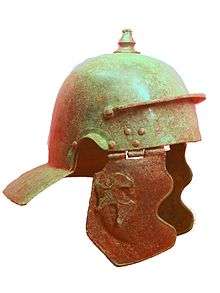Cohors I Ulpia Galatarum
| Cohors I Ulpia Galatarum | |
|---|---|
 Roman infantry helmet (late 1st century) | |
| Active | ? |
| Country | Roman Empire |
| Type | Roman auxiliary cohort |
| Role | infantry |
| Size | 480 infantry |
Cohors prima Ulpia Galatarum ("1st Ulpian cohort of Galatians") was a Roman auxiliary cohort of infantry.
Name
- Ulpia: Ulpian. The Imperial family name shows a link to the emperor Trajan (Marcus Ulpius Traianus).
- Galatarum: Galatians. At the time the unit was raised, the recruits came from the Roman province of Galatia.
Since there is no indication for milliaria and equitata, the unit was a Cohors quingenaria peditata with a nominal strength of 480 infantry (6 centuriae with 80 men each).
History
The unit was probably raised by Trajan in preparation for his Parthian campaign around 112/113.[1] It is attested on military diplomas for the province of Syria Palaestina issued in 136/137, 139, 142, 149/160, 158, 160 and 186.[1][2][3] In 238 it was at Aquileia in Italy, presumably as part of the exercitus Aquilensis.[1]
Garrisons
Possible garrisons were:[1]
Attested personnel
The following personnel is attested on inscriptions:[1][2]
Commanders
All commanders were prefects.
See also
References
- Julian Bennett: THE REGULAR ROMAN AUXILIARY REGIMENTS FORMED FROM THE PROVINCES OF ASIA MINOR, ANATOLICA XXXVII, 2011, Pages 251-274, (PDF).
- John Spaul: Cohors² The evidence for and a short history of the auxiliary infantry units of the Imperial Roman Army, British Archaeological Reports 2000, BAR International Series (Book 841), ISBN 978-1841710464
Citations
This article is issued from
Wikipedia.
The text is licensed under Creative Commons - Attribution - Sharealike.
Additional terms may apply for the media files.